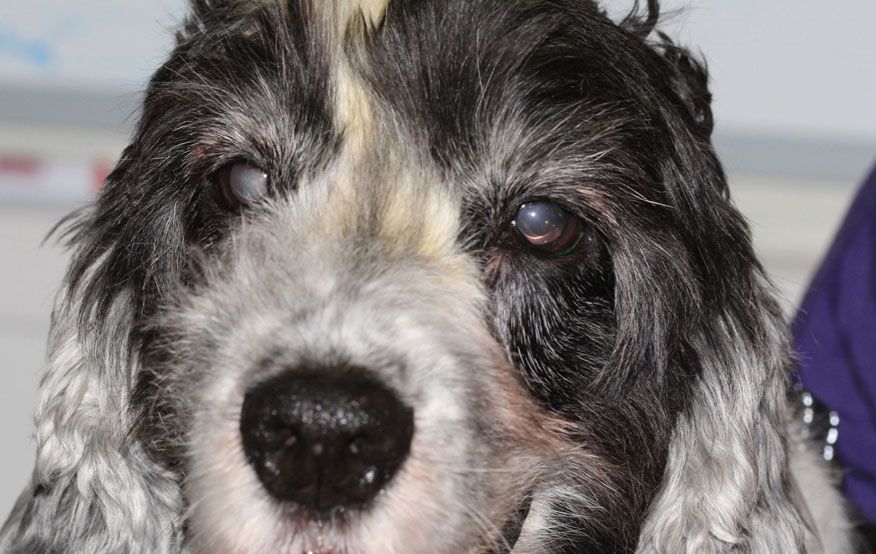Progressive Retinal Atrophy (PRA) is a debilitating eye condition that affects dogs and, in some cases, cats. This article explores the insidious nature of PRA, its impact on vision, and the hope that lies in ongoing research and support for affected pets and their owners.

The Mechanism Behind PRA
Understanding the intricate mechanisms that underlie Progressive Retinal Atrophy (PRA) is fundamental to grasping the severity of this condition. PRA is a genetic disorder that gradually dismantles a pet's visual perception by affecting the vital components of their retinas.
The retina, nestled at the back of the eye, is an astonishingly complex structure. It consists of specialized cells called photoreceptors, which include rods and cones. These photoreceptors play an indispensable role in converting light into electrical signals that the brain interprets as vision. It's a seamless process in healthy eyes, but in the case of PRA, it's a process fraught with disruptions.
PRA's Path of Destruction:
- Photoreceptor Degeneration: The hallmark of PRA is the progressive degeneration of photoreceptor cells, particularly the rods responsible for low-light vision. This degeneration is typically initiated by a genetic mutation.
- Loss of Function: As these photoreceptors deteriorate, their ability to capture and process light diminishes. This results in a decline in visual acuity, particularly in dim lighting conditions.
- Night Blindness: One of the early signs of PRA is night blindness. Affected pets struggle to see in low-light environments and may become hesitant or disoriented.
- Changes in Eye Appearance: PRA can also lead to distinct changes in the appearance of the eye. The retina may thin, blood vessels may become more prominent, and the tapetum lucidum, responsible for the characteristic eye shine in animals, may appear different.
The exact genetic mutations responsible for PRA can vary among breeds, making it a genetically diverse condition. This diversity also means that the age of onset and progression rate can differ widely.

Understanding the biological basis of PRA underscores the importance of early diagnosis and intervention. Identifying PRA in its incipient stages can be challenging, but it is the first crucial step in managing this condition effectively.
Recognizing PRA: Early Signs and Symptoms
Recognizing Progressive Retinal Atrophy (PRA) in its early stages is a formidable task, as its initial manifestations are often subtle and easy to overlook. However, vigilance in observing your pet's behavior and habits can make all the difference in providing timely care and support.
Signs and Symptoms of Early-Stage PRA:
- Night Blindness: One of the most characteristic signs of PRA is night blindness. Pets with PRA often struggle to see in low-light conditions. They may hesitate to move in dimly lit areas, bump into objects, or display unusual caution when navigating at night.
- Change in Eye Appearance: PRA can lead to noticeable changes in the eyes. The retina may begin to thin, blood vessels may become more visible, and the tapetum lucidum, responsible for the reflective eye shine seen in animals, may appear different. These changes can be subtle but are worth noting.
- Increased Reflectivity: In some cases, the eyes of pets with PRA may appear to have an increased reflectivity or glow when exposed to light, which can give the eyes an eerie or unusual appearance.
- Behavioral Changes: Affected pets may exhibit altered behavior, such as becoming more cautious or reluctant to engage in activities that require good vision.
- Difficulty Tracking Objects: PRA can impact a pet's ability to track moving objects, especially in low-light settings.
It's essential to remember that PRA progresses slowly, and early signs may be subtle. If you suspect that your pet is showing any of these signs or if you have concerns about their vision, consult with a veterinarian experienced in ophthalmology. Timely diagnosis and intervention can help manage PRA effectively and improve your pet's quality of life.
Breeds Predisposed to PRA
Progressive Retinal Atrophy (PRA) is not a condition that affects all breeds equally. Instead, it has a predilection for specific breeds due to the inheritance of certain genetic mutations. Understanding which breeds are predisposed to PRA can aid in early detection and proactive management.
Common Breeds Predisposed to PRA:
- Labrador Retriever: Labradors are among the breeds most commonly affected by PRA. This genetic predisposition underscores the importance of routine eye examinations for Labs.
- Poodle: Poodles, known for their intelligence and variety of sizes, are also at risk for PRA. Regular eye checkups are crucial for this breed.
- Cocker Spaniel: Cocker Spaniels have a higher likelihood of developing PRA, making it imperative for owners to be vigilant about changes in their pet's vision.
- Irish Setter: Irish Setters are prone to a specific form of PRA known as Irish Setter PRA. Early detection can help slow its progression.
- Dachshund: This long-bodied breed is also predisposed to PRA. Regular eye examinations are essential, especially as they age.
- Miniature Schnauzer: Miniature Schnauzers have a genetic susceptibility to PRA. Owners should be watchful for any signs of vision changes.
- English Springer Spaniel: English Springer Spaniels can develop late-onset PRA, making ongoing eye health monitoring crucial.
- Collie: Collies, including Rough and Smooth varieties, have a predisposition to PRA. Genetic testing can be beneficial for breeding dogs.
It's important to note that while these breeds have a higher likelihood of developing PRA, the condition can occur in other breeds and mixed-breed dogs as well. Therefore, vigilance and regular eye examinations are recommended for all dogs, regardless of their breed.

Diagnosis: Shedding Light on the Darkness
Diagnosing Progressive Retinal Atrophy (PRA) is a process that demands precision and expertise in veterinary ophthalmology. Early detection is paramount to implementing effective management strategies and supporting affected pets.
Steps in the Diagnosis of PRA:
- Comprehensive Eye Examination: A thorough examination of the eye's structures is the initial step in diagnosing PRA. This examination includes assessing the retina, optic nerve, and other relevant structures.
- Electroretinography (ERG): ERG is a specialized test used to evaluate the electrical activity of the retina. It can detect abnormalities in retinal function, aiding in the diagnosis of PRA.
- Genetic Testing: In some cases, genetic testing may be recommended, especially for breeds with known genetic mutations associated with PRA. This test can confirm the presence of specific genetic mutations linked to the condition.
- Observation of Clinical Signs: The veterinarian will pay close attention to the pet's clinical signs, such as night blindness and changes in eye appearance.
- History and Breed Predisposition: Information about the pet's breed, age, and family history can provide valuable insights into the likelihood of PRA. Certain breeds are more predisposed to the condition.
- Follow-Up Examinations: Since PRA progresses gradually, follow-up examinations are critical. Regular checkups can help monitor the progression of the condition and guide treatment decisions.
Once a definitive diagnosis of PRA is made, veterinarians can work with pet owners to develop a customized management plan. While PRA has no cure, early intervention and supportive measures can significantly enhance a pet's quality of life.
Living with a PRA-Diagnosed Pet
Caring for a pet diagnosed with Progressive Retinal Atrophy (PRA) necessitates a compassionate and understanding approach. While there is no cure for PRA, there are strategies and adjustments that can enhance your pet's quality of life.
Adaptations for Living with a PRA-Diagnosed Pet:
- Provide a Consistent Environment: Pets with PRA rely heavily on familiar surroundings. Minimize changes in their living environment to reduce stress and the risk of accidents.
- Keep Walks and Playtime Safe: Be cautious during walks, playtime, and exploration. Pets with PRA may struggle in unfamiliar or dimly lit areas, so always ensure their safety.
- Use Lighting Effectively: Adequate lighting indoors can improve your pet's visibility. Consider using night lights or brighter bulbs to help them navigate.
- Maintain a Routine: Stick to a consistent daily routine. Regular feeding times, bathroom breaks, and playtime can provide a sense of security.
- Remove Hazards: Pets can adapt remarkably well, but it's essential to remove potential hazards from their path, such as sharp objects or tripping hazards.
- Use Auditory Cues: Encourage your pet to rely on their other senses, like hearing. Using auditory cues can help them navigate and respond to commands.
- Provide Mental Stimulation: Engage your pet's mind with puzzle toys and interactive games that don't rely heavily on visual cues.
- Seek Veterinary Guidance: Regular checkups with a veterinary ophthalmologist are crucial for monitoring your pet's eye health and adjusting their care plan as needed.
Caring for a pet with PRA can be emotionally challenging, but with patience, love, and appropriate adjustments, they can continue to lead fulfilling lives.

Treatment Options and Management
While Progressive Retinal Atrophy (PRA) has no cure, several management strategies can slow its progression and improve your pet's quality of life.
Treatment and Management Approaches for PRA:
- Dietary Supplements: Certain dietary supplements and dog food, such as antioxidants and omega-3 fatty acids, may support retinal health. Consult your veterinarian for appropriate supplements for your pet.
- Environmental Adaptations: Make your home safe and accessible for your PRA-diagnosed pet. Use gates to block off dangerous areas, provide non-slip surfaces, and keep their living space clutter-free.
- Surgery: In some cases, surgery may be considered to address specific complications of PRA, such as lens luxation or retinal detachments.
- Medication: While medication cannot reverse PRA, it can help manage secondary conditions that may arise, such as glaucoma or cataracts.
- Regular Eye Checkups: Scheduled visits to a veterinary ophthalmologist are essential for monitoring the progression of PRA and adjusting the treatment plan as needed.
- Research Clinical Trials: Stay informed about ongoing clinical trials and research related to PRA. Some experimental treatments may offer hope for the future.
- Supportive Care: Provide your pet with emotional support and affection. The bond you share can make a significant difference in their well-being.
It's crucial to work closely with a veterinarian experienced in PRA to develop a tailored care plan that suits your pet's unique needs. While PRA presents challenges, proactive management can help your furry companion live a fulfilling life.
Research and Hope for the Future
The field of veterinary ophthalmology is continually advancing, offering hope for pets affected by Progressive Retinal Atrophy (PRA). Ongoing research endeavors and emerging technologies hold the promise of improved treatments and potential breakthroughs.
Promising Areas of Research for PRA:
- Gene Therapy: Researchers are exploring gene therapy approaches to target and correct the specific genetic mutations associated with PRA. These therapies aim to slow or halt the progression of the disease.
- Retinal Implants: Innovative retinal implant technologies are being developed to restore some level of vision to pets with advanced PRA. These implants can mimic the function of damaged photoreceptor cells.
- Pharmacological Interventions: Novel medications and pharmacological treatments are under investigation to address secondary complications of PRA, such as retinal inflammation and oxidative stress.
- Stem Cell Therapy: Stem cell therapy is being explored as a potential way to regenerate damaged retinal cells and improve vision in pets with PRA.
- Early Detection Tools: Improved diagnostic tools and genetic screening methods are in development to enable earlier detection of PRA in susceptible breeds.
While these advancements offer hope for the future, it's important for pet owners to stay informed about research developments and consider participating in clinical trials when appropriate. Collaborating with veterinarians and researchers can contribute to the ongoing progress in managing PRA.
Support and Resources for Pet Owners
Caring for a pet with Progressive Retinal Atrophy (PRA) can be both emotionally and practically challenging. Fortunately, there are numerous support networks and resources available to assist pet owners in navigating this journey.

Supportive Resources for Pet Owners:
- Veterinary Ophthalmologists: Seek guidance from specialized veterinary ophthalmologists who have experience in diagnosing and managing PRA. They can provide valuable insights and personalized care plans.
- Support Groups: Join online or local support groups dedicated to PRA and related eye conditions. Connecting with others who have faced similar challenges can provide emotional support and practical advice.
- Educational Websites: Explore reputable websites and organizations focused on pet eye health. These sources often offer informative articles, FAQs, and resources for pet owners.
- Books and Publications: Consider reading books and publications on PRA and pet eye health. These resources can deepen your understanding of the condition and offer practical tips.
- Pet Care Products: Investigate products designed to improve the quality of life for pets with visual impairments. These can include non-slip mats, tactile interactive dog toys, and assistive devices.
- Research Opportunities: Stay informed about ongoing research and clinical trials related to PRA. Participating in research studies can contribute to advancements in the field.
- Local Animal Associations: Connect with local animal associations and clubs, especially if you own a breed predisposed to PRA. They may offer breed-specific support and information.
The Emotional Toll: Coping with PRA
Coping with a pet diagnosed with Progressive Retinal Atrophy (PRA) can take a significant emotional toll on pet owners. Understanding and addressing these emotions is crucial for both you and your pet.
Emotional Challenges and Coping Strategies:
- Grief: It's natural to grieve the loss of your pet's vision and the life you envisioned for them. Allow yourself to process these emotions, and consider seeking support from a therapist or counselor if needed.
- Guilt: Some pet owners may experience guilt, believing they could have done something to prevent PRA. Remember that PRA is often hereditary, and it's not your fault.
- Anxiety: The uncertainty surrounding your pet's future can lead to anxiety. Consult with your veterinarian and develop a care plan to address your pet's needs and alleviate separation anxiety.
- Support Networks: Lean on friends, family, and support groups to share your feelings and experiences. Connecting with others who understand can provide emotional relief.
- Celebrate Small Victories: Focus on the accomplishments and the joy your pet brings to your life. Celebrate their resilience and adaptability.
- Pet-Owner Bond: Strengthen your bond with your pet through patience, love, and understanding. Your companionship is a source of comfort and security for them.
Preventing PRA: Is It Possible?
Preventing Progressive Retinal Atrophy (PRA) is a concern for many pet owners, especially those with breeds predisposed to the condition. While complete prevention may not be possible, responsible breeding practices can help reduce the prevalence of PRA.
Preventive Measures for PRA:
- Genetic Testing: Breeders can conduct genetic testing to identify carriers of PRA-related mutations. Responsible breeding includes avoiding mating two carriers to prevent affected offspring.
- Breeding Selection: Choose breeders who prioritize responsible breeding practices and screen their breeding animals for genetic mutations associated with PRA.
- Consult a Veterinarian: Before breeding a dog, consult with a veterinarian experienced in genetic counseling to assess the risk of PRA and make informed breeding decisions.
- Spaying and Neutering: If you have a pet with PRA or a carrier, consider spaying or neutering to prevent the passing of PRA-related genes to future generations.
While these measures can reduce the risk of PRA in specific breeds, it's important to remember that the condition can still occur sporadically in other breeds and mixed-breed dogs.
The Importance of Regular Veterinary Checkups
Regular veterinary checkups play a pivotal role in the overall health and well-being of your pet, particularly when dealing with conditions like Progressive Retinal Atrophy (PRA).
Key Aspects of Regular Veterinary Checkups:
- Early Detection: Routine eye examinations can lead to the early detection of PRA. Identifying the condition in its early stages allows for timely intervention and management.
- Monitoring Progression: For pets diagnosed with PRA, regular checkups enable veterinarians to monitor the progression of the disease and make necessary adjustments to the treatment plan.
- Preventive Care: Veterinarians can provide guidance on preventive care measures to maintain your pet's overall health. This includes recommendations for nutrition, exercise, and vaccinations.
- Addressing Concerns: If you notice any changes in your pet's behavior, vision, or overall health, regular checkups offer an opportunity to address these concerns promptly.
- Holistic Care: Veterinarians can take a holistic approach to your pet's well-being, addressing not only the specific condition like PRA but also their overall quality of life.
By adhering to a schedule of regular veterinary checkups, you can proactively manage your pet's health and provide them with the best possible care, ensuring they lead happy and comfortable lives, even in the presence of conditions like PRA.
Conclusion
In conclusion, Progressive Retinal Atrophy is a complex condition that affects pets and their owners profoundly. By raising awareness, supporting research, and providing compassionate care, we can shine a light on PRA and work towards a brighter future for affected pets.
FAQs about Progressive Retinal Atrophy
Q1: Can PRA be cured?
A1: Unfortunately, there is no cure for PRA at this time. However, various management strategies can slow its progression and improve a pet's quality of life.
Q2: Is PRA more common in older dogs?
A2: PRA can affect dogs of any age, but it typically becomes noticeable in middle-aged to older pets.
Q3: Can cats get PRA too?
A3: Yes, cats can also develop PRA, although it is more commonly seen in dogs.
Q4: What are the emotional challenges of caring for a pet with PRA?
A4: Caring for a pet with PRA can be emotionally challenging, leading to feelings of grief, guilt, and anxiety. Seeking support from veterinarians and support groups is essential.
Q5: Are there any experimental treatments for PRA?
A5: While there are ongoing research efforts, there are currently no experimental treatments for PRA. Pet owners are encouraged to explore management strategies with their veterinarians.

